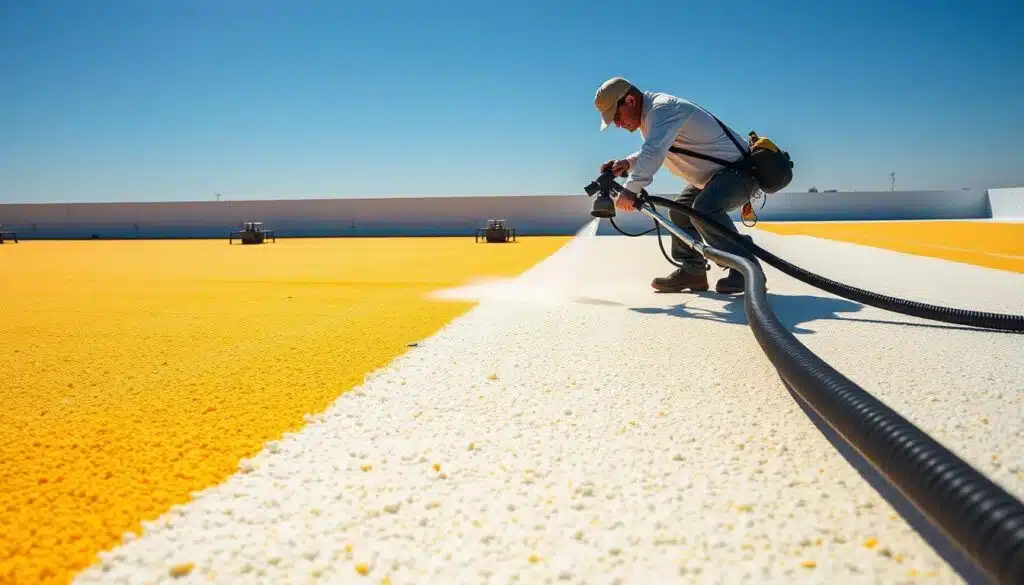Homeowners and contractors are looking for efficient and durable roofing options. Spray foam roofing is becoming a top choice. It offers great insulation and long-lasting protection. But, it’s important to know about the dry time and other key details for a successful installation.
Key Takeaways
- Spray foam roofing is a versatile and efficient roofing solution that provides superior insulation and moisture barrier properties.
- The dry time for spray foam roofs can vary depending on factors such as temperature, humidity, and application thickness, but typically ranges from 24 to 72 hours.
- Proper curing of the spray foam is essential for achieving the desired performance and durability of the roofing system.
- Spray foam roofs offer numerous benefits, including enhanced energy efficiency, cost-effectiveness, and environmental sustainability.
- The installation process for spray foam roofs requires specialized expertise and equipment, ensuring a seamless and reliable application.
What is Spray Foam Roofing?
Spray foam roofing is a modern roofing solution. It combines durability, energy efficiency, and versatility. It uses a special mix of chemicals that expand and harden to create a solid roof barrier.
Understanding the Composition and Application
Spray foam roofing has two main parts: polyol resin and isocyanate. When mixed and sprayed, they react and expand. This forms a solid, continuous layer on the roof.
This process makes a durable, closed-cell structure. It seals the roof well, offering great insulation and moisture resistance.
Applying spray foam roofing needs skilled professionals. A special machine mixes and sprays the chemicals. This ensures a smooth, even layer without seams or joints that can leak.
| Spray Foam Roofing Components | Description |
|---|---|
| Polyol Resin | A key ingredient that, when combined with the isocyanate, undergoes a chemical reaction to form the expanded foam. |
| Isocyanate | The second essential component that, when mixed with the polyol resin, catalyzes the chemical reaction and causes the foam to expand. |
Understanding how spray foam roofing is applied is key. It ensures the system works well over time. Homeowners and contractors can make better choices knowing how it’s made and applied.
Everything to Know About Spray Foam Roofs and Its Dry Time
Spray foam roofing is known for its great insulation and lasting durability. But, knowing how long it takes to dry is key for homeowners and contractors. Let’s explore the details of spray foam roofs and their drying time.
The dry time for spray foam roofing is when it changes from liquid to solid. This curing process is vital. It ensures the foam is fully dry before the roof is ready for use. The dry time can be between 24 to 72 hours, depending on several factors.
Factors Affecting Spray Foam Roof Dry Time
- Ambient temperature and humidity levels: Warmer and drier conditions can speed up curing. Cooler and more humid environments slow it down.
- Thickness of the foam application: Thicker foam takes longer to dry than thinner layers.
- Type of spray foam used: Different types of foam have different dry times, based on their chemical makeup.
- Ventilation and air circulation: Good airflow helps dry and cure the foam faster.
It’s important to wait for the foam to fully cure before using the roof. Applying coatings or finishes too soon can harm the foam’s structure and performance. This could lead to problems later on.
| Spray Foam Roof Dry Time | Average Duration |
|---|---|
| Initial Drying | 24-48 hours |
| Complete Curing | 48-72 hours |
Understanding the dry time and curing process of spray foam roofing is crucial. Homeowners and contractors can ensure a successful and lasting installation by knowing this. With the right timing and patience, this innovative roofing solution can offer its full benefits.
Benefits of Spray Foam Roofing
Spray foam roofing is a top choice for homes and businesses. It boosts energy efficiency and lasts a long time. This roofing tech offers many benefits that can greatly enhance your building’s performance and life span.
Energy Efficiency and Moisture Barrier
Spray foam roofing is great at keeping temperatures steady. Its closed-cell structure blocks heat and cold, saving energy. This makes your space more comfortable and cuts down on heating and cooling costs.
It also stops water from getting in, protecting your roof and inside from damage. This is a big plus for keeping your building dry and safe.
Durability and Cost-Effectiveness
Spray foam roofing is very durable. It stands up well to weather, UV rays, and physical damage. This means your roof will last longer, saving you money on repairs and replacements.
In summary, spray foam roofing is a top pick for its energy savings, moisture protection, and long-lasting quality. It’s a smart choice for those looking for a reliable and affordable roofing solution.
The Installation Process
Turning your roof into a spray foam masterpiece is a detailed task. It needs the skill of seasoned pros. The installation process has key steps for a smooth and lasting finish. Let’s explore them:
- Preparation: First, the roof surface gets a deep clean and any old roofing is taken off. This makes the surface ready for the spray foam.
- Application: The foam is sprayed on in layers to get the right thickness and insulation. It’s watched closely to make sure it covers evenly and without gaps.
- Curing: After applying, the foam needs time to harden completely. This step is vital for the roof’s strength and to last through weather for years.
It’s crucial to hire licensed and skilled installation process contractors. They know how to handle this special roofing job. They ensure the foam is applied, cured, and ready for long-term use.
| Step | Description | Timeline |
|---|---|---|
| Preparation | Cleaning and removing existing roofing materials | 1-2 days |
| Application | Precise application of spray foam in multiple layers | 1 day |
| Curing | Allowing the spray foam to fully harden and set | 24-48 hours |
Knowing the detailed installation process and choosing the right pros ensures your spray foam roof is done right. It will protect your property for a long time.
Environmental Impact of Spray Foam Roofing
The need for green building materials is growing fast. Spray foam roofing is getting more attention for its environmental effects. It’s known for being energy-efficient and long-lasting, but its green credentials are being questioned.
Sustainable Roofing Materials
Spray foam roofing helps buildings use less energy. This means they need less heating and cooling, which cuts down on carbon emissions. It’s a big step towards reducing our environmental impact.
But, making traditional spray foam has raised some green flags. It uses chemicals like HFCs, which harm the ozone layer and contribute to global warming. To address these issues, the industry is exploring greener options. They’re looking into bio-based or recycled materials.
| Sustainable Roofing Material | Key Characteristics |
|---|---|
| Soy-Based Spray Foam | Made from renewable soy-based ingredients, reducing the reliance on petroleum-based products. |
| Recycled Plastic Spray Foam | Utilizes recycled plastic materials, diverting waste from landfills and reducing the demand for virgin resources. |
| Mineral Wool Insulation | A natural, inorganic material made from volcanic rock or industrial slag, providing excellent thermal and acoustic insulation. |
The construction world is focusing more on being green. New, eco-friendly spray foam roofing options are key. By choosing these alternatives, we can enjoy spray foam’s benefits while being kinder to the planet.
Conclusion
This article has looked closely at spray foam roofing. It covered its makeup, how it’s installed, its benefits, and its effect on the environment. Understanding dry time and other important details helps readers decide if spray foam is right for them.
The article highlighted spray foam’s advantages. These include saving energy, keeping moisture out, lasting long, and being cost-effective. This information helps readers understand spray foam roofing better.
By exploring “everything to know about spray foam roofs and its dry time,” readers are better equipped to choose their roofing. The article covered spray foam’s innovative makeup and its eco-friendly nature. Now, readers can confidently pick and install spray foam roofs.
If you want to learn more or consider a spray foam roof, call 424-253-6438. This knowledge helps homeowners and business owners make smart choices. It improves their roofing’s efficiency, durability, and eco-friendliness.
FAQ
What is spray foam roofing?
Spray foam roofing is a roofing system made from chemicals. It creates a seamless, durable, and energy-efficient layer. The two main components mix and expand to form the foam.
How long does it take for spray foam roofs to dry?
Drying time for spray foam roofs is important. It usually takes 24-72 hours for the foam to solidify. This depends on temperature and humidity.
What are the benefits of spray foam roofing?
Spray foam roofing improves energy efficiency and acts as a moisture barrier. It’s also durable and cost-effective in the long run. The foam’s insulating properties lower energy bills and protect against water damage.
How is spray foam roofing installed?
Installing spray foam roofing involves preparation, application, and curing. It’s essential to work with experienced contractors. This ensures the foam dries fully before the roof is ready.
What is the environmental impact of spray foam roofing?
Spray foam roofing can be good for the environment. It helps save energy and reduces carbon footprint. Yet, there are concerns about chemical use. New eco-friendly formulas are making spray foam a greener option.





